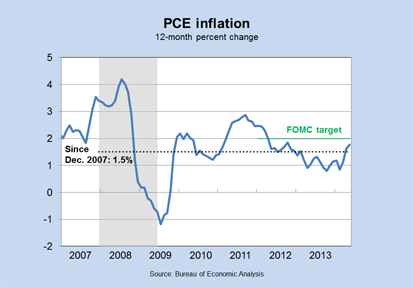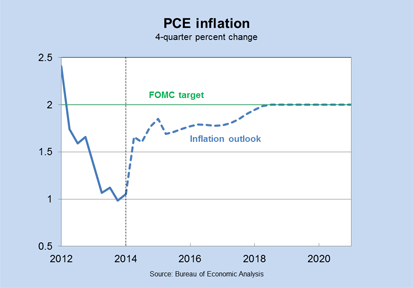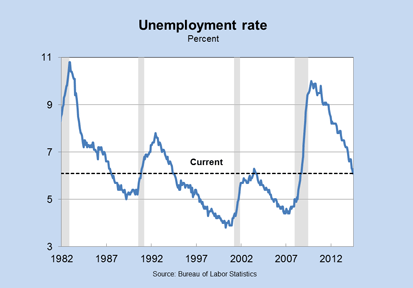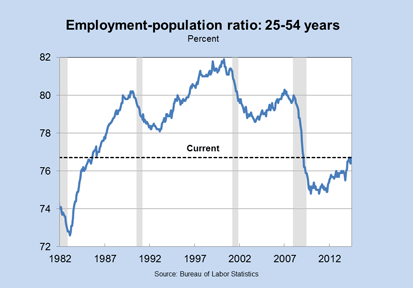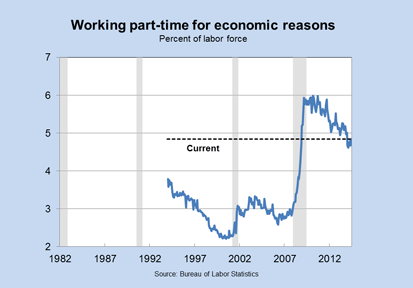- Media QA(video)
Note*
Thanks for the introduction, and thank you for the invitation to join you here today. It’s a pleasure to speak to the Partnership again.
I’ll begin my speech with some basics about the Federal Reserve System and the Federal Open Market Committee (the FOMC). But the bulk of my remarks should be viewed as a quarterly report of sorts. Your elected representatives, the Congress of the United States, have charged the Federal Reserve with achieving key macroeconomic goals. My speech will be a report to you, the Minnesota Business Partnership, about how the FOMC is doing in terms of achieving those goals. Please keep in mind, though, that I will be expressing my own views, and they are not necessarily those of others in the Federal Reserve System.
I look forward to responding to, and learning from, your questions at the conclusion of my remarks.
Federal Reserve System Basics
Let me begin with some basics about the Federal Reserve System. I like to tell people that the Fed is a uniquely American institution. What do I mean by that? Well, relative to its counterparts around the world, the U.S. central bank is highly decentralized. The Federal Reserve Bank of Minneapolis is one of 12 regional Reserve Banks that, along with the Board of Governors in Washington, D.C., make up the Federal Reserve System. Our Bank represents the ninth of the 12 Federal Reserve districts and includes Montana, the Dakotas, Minnesota, northwestern Wisconsin and the Upper Peninsula of Michigan.
Eight times per year, the FOMC meets to set the path of interest rates over the next six to seven weeks. All 12 presidents of the various regional Federal Reserve Banks—including me—and the seven governors of the Federal Reserve Board contribute to these deliberations. However, the Committee itself consists only of the governors, the president of the Federal Reserve Bank of New York and a rotating group of four other presidents. I’m one of those four presidents this year. In this way, the structure of the FOMC mirrors the federalist structure of our government, because representatives from different regions of the country—the various presidents—have input into FOMC deliberations.
At those eight meetings, the FOMC decides on the level of monetary stimulus for the economy. I won’t get into too many details of what that term “monetary stimulus” means, although I’m more than happy to take questions about it later. For now, I’ll just make three high-level points. First, when the FOMC changes the level of stimulus, our actions tend to push inflation—that is, the rate of growth of prices—and employment in the same direction. Raising the level of stimulus puts upward pressure on both inflation and employment. Lowering the level of stimulus puts downward pressure on both inflation and employment. Second, the FOMC’s actions only affect inflation and employment with a lag, usually thought to be about one-and-a-half to two years. Finally, over the long run, monetary policy is the prime determinant of the overall rate of inflation in the economy, but many factors beyond monetary policy affect the long-run level of employment.
What is the FOMC seeking to achieve by varying the level of monetary stimulus? Congress has charged the FOMC with making monetary policy to promote price stability and to promote maximum employment. The FOMC has interpreted the first goal, price stability, to mean keeping inflation close to 2 percent. The FOMC’s job is to vary monetary stimulus over time to meet these mandated objectives.
The remainder of my speech will take the form of a report to you about how the FOMC is doing in terms of meeting these goals set for us by your elected representatives in Congress.
Price Stability
I will start with price stability. Again, operationally, the FOMC has translated this into keeping the rate of increase of the price level—that is, the inflation rate—close to 2 percent. Even more specifically, the FOMC uses what’s called the personal consumption expenditure price index, or PCE, to calculate inflation. This measure of inflation captures the rate of increase in all goods and services, including those related to food and energy.
The Great Recession is dated as starting in December 2007. Here’s a graph of how PCE inflation has behaved since that date.
The main take-away is that, since the beginning of the Great Recession, the PCE inflation rate has averaged 1.5 percent per year.
In some sense, going back to 2007 is a little misleading, because the FOMC did not adopt its 2 percent inflation target until January 2012. However, even since that decision, PCE inflation has been running lower than 2 percent.
So, whether we look over the past six years or over the past two years, inflation has been running too low to be consistent with price stability. The good news is that the FOMC does expect inflation to turn back toward 2 percent. However, that return to 2 percent could take a long time. For example, the minutes from the April FOMC meeting reveal that the Federal Reserve Board staff outlook is for inflation to remain below 2 percent over the next few years. In a similar vein, earlier this year, the Congressional Budget Office (CBO) predicted that inflation will not reach 2 percent until 2018—more than 10 years after the beginning of the Great Recession.
This subdued inflation forecast may be surprising to some of you. After all, as you look at the chart, you can see that PCE inflation has risen relatively rapidly over the past three months and is now 1.8 percent—very close to the FOMC’s target. But the chart also clearly shows that many large fluctuations in PCE inflation end up being purely transitory. To formulate an accurate forecast for inflation, we need to look through these transitory fluctuations, no matter how large they might be—and that’s not always easy.
Of course, my forecast is only a forecast. I am extremely confident that the actual path of inflation over the next four years will turn out to be higher or lower than what I currently expect it to be! What you should take away, though, is that I currently see the probability of inflation’s averaging more than 2 percent over the next four years as being considerably lower than the probability of inflation’s averaging less than 2 percent over the next four years. And that’s why I conclude my discussion of inflation by saying that the FOMC is undershooting its price stability goal.
Low Inflation: Why It Matters
I’ve told you that inflation has been, is and will be too low relative to the FOMC’s target of 2 percent. But why should you care that inflation is too low? Isn’t it a good thing when goods and services aren’t as expensive to buy? There are two answers to this—very good—question.
The first answer is that borrowers and lenders in our economy count on the Federal Reserve to deliver the inflation rate it targeted. If inflation is higher than the target, lenders are harmed because they receive payments that are smaller than they expected in real terms. Put another way, they can buy fewer goods and services with their payments than they expected. If inflation is lower than the target, borrowers are harmed because they must make payments that are larger than they expected in real terms. Why is that? When inflation is below target, goods and services are indeed cheaper, but wages also tend to be lower. Depressed wages mean that a family’s mortgage payment consumes a larger fraction of the family’s income than they expected when they took out the loan. That unexpectedly high mortgage payment harms the family, and it’s a harm that the FOMC can prevent by achieving the inflation rate that it targeted.
The second answer is: You should care about below-target inflation because it signals a significant problem in our economy.
Let me explain what I mean. At a basic level, you should think of prices as a signal about how our economy is using its available resources. In 2012, I had an experience that brought home this intuition in a very clear way. I visited Williston, on the western edge of North Dakota. As it is today, when I visited Williston, it was in the heart of a major oil boom. That boom was pushing hard on the physical resources—like roads, water, housing—available to Williston and pushing hard on the human resources available to Williston. The result was relatively high inflation.
So, when inflation is high compared to the Fed’s target, like it was in Williston, we know that demand is pushing hard on available resources. The converse is also true: Inflation is low compared to the Fed’s target when the demand for goods and services is too low to fully use the available resources in society. The low inflation in the United States tells us that resources are being wasted.
What exactly are these wasted resources? There are multiple answers to this question—when demand is too low, lots of resources are left unused. But the biggest and most disturbing answer is our fellow Americans. There are many productive people in the United States available to work more hours, and our society is deprived of their production.
This key point is generally underappreciated. I’ve said that the FOMC is undershooting its price stability objective and is expected to continue to do so. But we should all keep in mind that this outcome—and especially the forecast for continued undershooting—typically means that the FOMC is also underperforming on its other objective of promoting maximum employment.
Should the FOMC Make Up for Past Inflation Misses?
I’ve described how I expect that the PCE inflation rate will run below the FOMC’s 2 percent target for several years—possibly until 2018. Let’s assume that forecast turns out to be right. This outcome raises a key policy question: How should the FOMC’s inflation goals in the years following 2018 be influenced by the undershooting of the inflation target in the preceding years?
In addressing this question, I’ll compare two possible approaches: the standard approach of inflation targeting and the more novel approach of price level targeting. Let me note before I begin that I won’t take a stand today on which of those approaches is better. My goal is simply to initiate a policy conversation about future—indeed, possibly far-off future—monetary policy choices.
The FOMC announced its 2 percent inflation target in January 2012. Since that date, inflation has averaged about 1.4 percent per year. As I noted earlier, I anticipate that inflation will rise only slowly. As you know, the inflation rate is the growth rate of the price level—that is, how much people pay for a typical bundle of goods and services. Hence, the downside misses with respect to inflation cumulate into a significantly lower price level. If my inflation forecast is right, the price level in 2018 will be about 2.2 percent below what it would have been had the FOMC hit its inflation target over the preceding six years.
How should the FOMC respond to this shortfall in the price level? If the FOMC simply targets a 2 percent inflation rate after 2018, then the price level will be permanently 2.2 percent lower than was expected in 2012. This approach to policy—which is the standard one followed by most leading central banks around the world—is called inflation targeting. But there is an alternative: The FOMC could target a slightly higher inflation rate for a few years after 2018 in order to make up for the shortfall in the price level. This latter policy approach is often termed price level targeting.
Why would the FOMC want to use price level targeting? There are two reasons—and they are closely related to the concerns about low inflation that I raised earlier.
The first reason is that price level targeting makes long-term contracts safer for borrowers and lenders. For example, suppose a family took out a 30-year mortgage in 2012, under the expectation that the FOMC would deliver on its commitment to keep inflation at 2 percent. Because inflation has been so low over the past two years, the borrower’s current repayments are now surprisingly expensive in real terms. (By “real terms,” I mean that the borrower has to give up a surprising amount of goods and services to be able to afford the repayments.) The FOMC can’t solve that problem today, of course. But if the FOMC uses inflation targeting, the borrower’s repayments are likely to remain surprisingly expensive in real terms even in 2042, 30 years after taking out the mortgage. In contrast, if the FOMC uses price level targeting, the borrower’s repayments in 2042 are likely to be close, in real terms, to what the borrower expected when originally taking on the loan.
The second reason that the FOMC might want to use price level targeting is that it would serve as an automatic stabilizer for the economy. As I described earlier, when demand is low, inflation tends to be below target. With price level targeting, the FOMC makes up for low inflation by using monetary policy to stimulate higher future inflation and higher future demand. But this prospect of higher future demand is an incentive for businesses to hire and invest more now. Thus, with price level targeting, the FOMC’s anticipated future policy choices automatically offset current adverse shocks.1
I’ve framed the decision about inflation targeting versus price level targeting in terms of its impact on the FOMC’s future policy decisions. As I’ve just talked through, though, these future decisions have the potential to affect near-term macroeconomic outcomes. In particular, if the FOMC were to decide today to follow price level targeting, then businesses would anticipate more stimulative future monetary policy and, consequently, higher future demand. That expectation of higher demand would provide an additional incentive for them to hire and invest today. In this way, the FOMC’s decision about price level targeting—a decision about choices to be made several years from now—has the potential to affect the near-term speed of the economy’s recovery.
I suspect that all of this sounds pretty dry to some of you. I assure you that the debate over price level versus inflation targeting is about as exciting as central banking can get! I’m certainly not trying to resolve that debate today. In particular, I’ve not talked at all about the thorny and important question of how the FOMC should respond to past overshooting of its inflation target. But I do think that the question of whether to target the inflation rate or the price level should be a subject for serious discussion among central bankers.
Maximum Employment
I’ve argued that the low inflation rate is a signal that the FOMC is underperforming with respect to its maximum employment objective. But we don’t need to rely on this signal to reach this conclusion. We can readily see this underperformance in numerous key metrics of labor market performance.
I’ll begin by showing you data on the evolution of the unemployment rate. In March 2007, the unemployment rate was 4.4 percent. It rose slowly throughout 2007 to reach 5 percent by the end of the year. The National Bureau of Economic Research dates the Great Recession as having begun in that month. In the wake of the recession, the unemployment rate reached a peak of 10 percent in October 2009.
Since that date—over four years ago!—the unemployment rate has fallen slowly to 6.1 percent. While this decline reflects a welcome improvement, the current unemployment rate remains above most forecasts of its expected long-run level. Personally, I expect that, over the long run, the unemployment rate will converge to just over 5 percent.
But I would say that this measure could well overstate the degree of improvement in the U.S. labor market. To estimate the unemployment rate, the Census Bureau asks people two questions: Are you working? And, if not, have you looked for work in the past four weeks? The unemployment rate measures the ratio of the second number—the recent job searchers—to the sum of the two numbers (the recent job searchers and the workers). This means that the unemployment rate can decline for two reasons: because more people are finding work or because fewer people are looking for work. Much of the decline in the unemployment rate since October 2009 has occurred because the fraction of people who are looking for work has fallen. This characterization is borne out if we look at the evolution of the fraction of people over the age of 16 who have a job—what’s called the employment-to-population ratio.
In March 2007, the employment-to-population ratio was over 63 percent. The employment-to-population ratio fell sharply during the Great Recession and bottomed out at just over 58 percent in mid-2011. The percentage has risen little from this low point and remains lower than at any time between 1986 and 2007.
It is true that, even without the Great Recession, demographic forces would have led to some decline in the employment-to-population ratio since 2007. As the baby boom birth cohort—born between 1946 and 1964—ages, the fraction of retirees in the population grows steadily. But these demographic forces are still not large enough to account for most of the decline in the employment-to-population ratio that I’ve described. One way to see this—but not the only way—is to focus on people who are outside the normal retirement age. Here, I’ve plotted the fraction of the population aged 25 to 54 who have a job. This ratio has improved from its low point, but also remains lower than at any time between 1986 and 2007.
Even among those who have a job, there are signs that the economy is significantly underemploying our human resources. The Bureau of Labor Statistics reports each month on the number of Americans who are working part time, would like to work more hours, but are unable to obtain those additional hours. That fraction of the labor force has fallen, but remains unusually high.
To summarize what we learn from the charts: The good news is that the labor market has improved since the end of the Great Recession. The bad news is that the rate of improvement over the past four-plus years has been painfully slow. As a consequence, there is still significant underutilization of our country’s most important resource—its people. We have to conclude that the FOMC is underperforming with respect to its goal of promoting maximum employment.
Conclusions
Earlier, I asked you to consider this speech as a report to you on the FOMC’s performance with respect to its two congressionally mandated objectives. We’ve seen that the FOMC is undershooting its price stability objective, in that inflation is running below the FOMC’s goal of 2 percent and is expected to remain low for several years. The undershooting is problematic because it suggests that the American economy is wasting available resources, especially its human resources. We’ve seen evidence of this underutilization in the performance of key labor market metrics. Hence, the FOMC is also underperforming with respect to its maximum employment objective. I continue to believe that we need to do better as a Committee.
Thank you for listening. I’d be happy to take your questions.
Note
* Thanks to Manuel Amador, David Fettig, Terry Fitzgerald and Sam Schulhofer-Wohl for their assistance with these remarks and the supporting materials.
Endnote
1 See, for example, Gauti Eggertsson and Michael Woodford, 2003, “The Zero Bound on Interest Rates and Optimal Monetary Policy,” Brookings Papers on Economic Activity.



